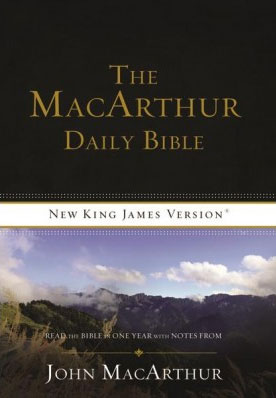Devotionals
Daily Bible - November 30
A devotional by Grace To You for reading on November 30th
Reading for Today:
- Daniel 3:1 –4:37
- Psalms 136:1-9
- Proverbs 29:11
- 2 Peter 1:1-21
Notes:
Daniel 3:1 image of gold. The statue, which the king arrogantly made, represented himself as an expression of his greatness and glory and reflected the dream where he was the head of gold (2:38). It was not necessarily made of solid gold, but more likely would have been overlaid with gold, like many objects found in the ruins of Babylon. The word for “image” usually means a human form. The height of the figure was about 90 feet and the width 9 feet; it would have been comparable in height to date palms found in that area. The self-deifying statue of the king need not have been grotesquely thin in proportion to the height since a massive base could have contributed to the height. This established the worship of Nebuchadnezzar and the nation under his power, in addition to the other gods.
Daniel 3:15 who is the god…? The king’s challenge would return to embarrass him. The true God was able to deliver, just as He was able to reveal a dream and its meaning. Nebuchadnezzar had earlier called him “the God of gods” (2:47); but having let that fade from his attention, he soon would be shocked and humiliated when God took up his challenge (3:28, 29).
2 Peter 1:4 partakers of the divine nature. This expression is not different from the concepts of being born again, born from above ( John 3:3 ; James 1:18 ; 1 Pet. 1:23), being in Christ (Rom. 8:1), or being the home of the Trinity ( John 14:17 –23).The precious promises of salvation result in becoming God’s children in the present age ( John 1:12 ; Rom. 8:9; Gal. 2:20; Col. 1:27), and thereby sharing in God’s nature by the possession of His eternal life.
2 Peter 1:21 by the will of man. As Scripture is not of human origin, neither is it the result of human will. The emphasis in the phrase is that no part of Scripture was ever at any time produced because men wanted it so. The Bible is not the product of human effort. The prophets, in fact, sometimes wrote what they could not fully understand (1 Pet. 1:10, 11), but were nonetheless faithful to write what God revealed to them. moved by the Holy Spirit. Grammatically, this means that they were continually carried or borne along by the Spirit of God. The Holy Spirit thus is the divine author and originator, the producer of the Scriptures. In the Old Testament alone, the human writers refer to their writings as the words of God over 3,800 times (e.g., Jer. 1:4; 3:2; Rom. 3:2; 1 Cor. 2:10). Though the human writers of Scripture were active rather than passive in the process of writing Scripture, God the Holy Spirit superintended them so that, using their own individual personalities, thought processes, and vocabulary, they composed and recorded without error the exact words God wanted written. The original copies of Scripture are therefore inspired, i.e., God-breathed (2 Tim. 3:16) and inerrant, i.e., without error ( John 10:34 , 35; 17:17; Titus 1:2 ). Peter defined the process of inspiration which created an inerrant original text (Prov. 30:5; 1 Cor. 14:36; 1 Thess. 2:13).
DAY 30: Who was the fourth person in the fiery furnace of Daniel 3:1 9–25?
The delivery of Shadrach, Meshach, and Abed-Nego from the flames was an astonishing, miraculous event. The furnace was real, and the flames were hot. The guards who carried the young men close enough to cast them in the furnace were killed. Why complicate this miracle with a fourth person in the furnace? Because the king himself noticed the discrepancy between the number he had thrown into the flames and the number he saw strolling about. The truth usually includes unexpected complications.
The king concluded the fourth person was a heavenly being. He identified the visitor in two different ways: 1) “like the Son of God” (3:25); 2) “Angel” (3:28). When he commanded the three friends to exit the furnace, the king did not extend an invitation to God’s special servant.
Viewed from the context of all of Scripture, the fourth person could possibly have been the Second Person of the Godhead (Jesus Christ) in a preincarnate appearance. For other similar Old Testament instances, see Exodus 3:2 , Joshua 5:13 –15, and Judges 6:11 ff. While the term “Angel” is used in these reports, the person had a special connection with the Lord. He wasn’t an angel, but the Angel of the Lord. His presence may be startling but He does not have the stunning and awe-inspiring appearance of an angel. The king saw four men in the furnace. The one who appeared miraculously he identified as the Son of God. It may well have been an inspired exclamation.
From The MacArthur Daily Bible Copyright © 2003. Used by permission of Thomas Nelson Bibles, a division of Thomas Nelson, Inc, Nashville, TN 37214, www.thomasnelson.com.
Additional Resources- Download our app The Study Bible!
- John MacArthur’s complete sermon archive
- The MacArthur Study Bible
- The complete MacArthur New Testament Commentary series
The content above belongs exclusively to Grace To You - Daily Bible and is provided on HopeLife.org for purely non-profit purposes to help extend the reach of their ministry.
Copyright 2016 by John MacArthur. Used by permission from Grace to You.



